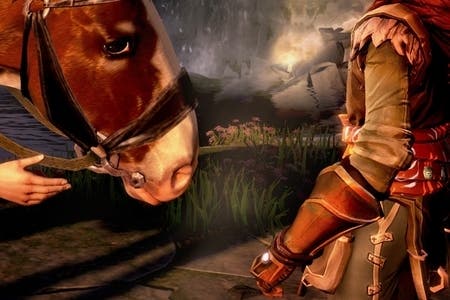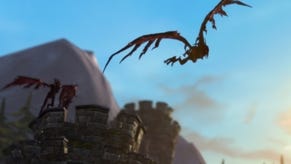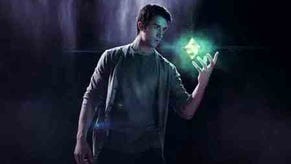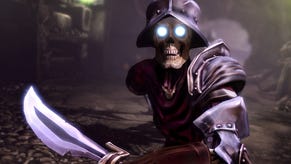Fable: The Journey review
Horseplay.
Motion control cannot be recalled. It cannot be uninvented. But, like the fake plastic guitars of the past, the stereoscopic 3D of the future and all those other tech gimmicks that sizzle in and fizzle out, it will in time be removed from our video games. In that sense Fable: The Journey feels like a line drawn under this chapter in the medium, a chapter that's involved an awful lot of rearranging furniture and messing with curtains - a chapter of hand-waving followed by hand-wringing as we've calibrated and recalibrated the blink-less eye of the Kinect sensor.
That much is true of Lionhead's latest excursion to Albion, too - the green, pleasant, accent-rich hinterland into which we now dive via a lens rather than plastic controller, hoping our sorcerer's arm sweeps will translate somehow to the screen. It is, as with all Kinect games, at times stubborn and petulant, pretending to misunderstand your bodily instructions, as if its eyesight is beginning to fail as the Xbox enters its dotage. But goodness, the only thing more tiresome than wrestling with an insubordinate Kinect is reading about how a game's motion controls don't quite work. In truth, Fable: The Journey's controls mostly work the way that they should, provided the sun is at the right point in the sky, the children are put to bed and the wind is still.
Nevertheless, if journey is story - and video game players understand more than anyone that journey is story - then you must accept that a Kinect-driven journey will feature the odd paragraph in which a disgruntled human gesticulates madly at a television set while swearing a lot. It's not much fun to read, but it goes with this chapter in the medium.
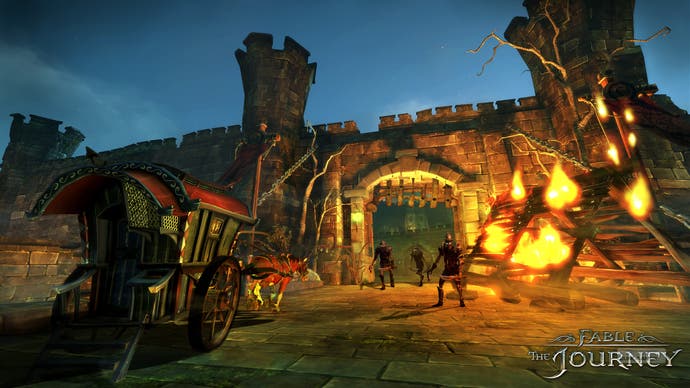
You play as Gabriel, the first named protagonist in the series, a plainly likeable young man prodded by destiny, and for the vast majority of the game you view the world through his first-person eyes. This is less important than the fact that Fable: The Journey is an on-rails RPG. It's linear in the way that a railway track is linear, and anybody who tries to tell you otherwise is not to be trusted. You move through Albion on a fixed, immovable footpath: Time Crisis on a field trip. You cannot turn your head, let alone turn back, instead relentlessly moving forward, either on horse carriage or your own two feet. The only choice you have is to stop every now and again to pop off the horse, called Seren, in order to plunder a side-cave, or perhaps to groom her matted hair.
Microsoft has been scared to admit this fact in the marketing preamble, but there's something remarkably honest about this game design approach. So many cine-game blockbusters from the past few years have been linear journeys that pay lip-service to player agency. You're given a few metres of leeway either side to explore, but otherwise you trot down the corridor and don't you f***ing dare turn around. In Fable: The Journey there is no pretence. A team of designers has meticulously laid a rollercoaster track for you. Sit back, rest in their pacing, savour their controlled camera angles, gasp at their pyrotechnical timings. Relax, they say, like comely tour guides: enjoy the Journey.
Which isn't to say that your role as participant is redundant. Your will can be expressed in this world in a number of ways. When travelling in your horse-drawn carriage you take the reins, electing when to drive your steed into a canter or a sprint, ensuring that you slow to a trot when crossing cobblestones. Push one arm out in front of the other and you turn her course, although only enough to walk her into the experience point pick-ups, to set her straight against the tug of the wind, or to avoid on-the-ground obstacles that might damage her old hooves.
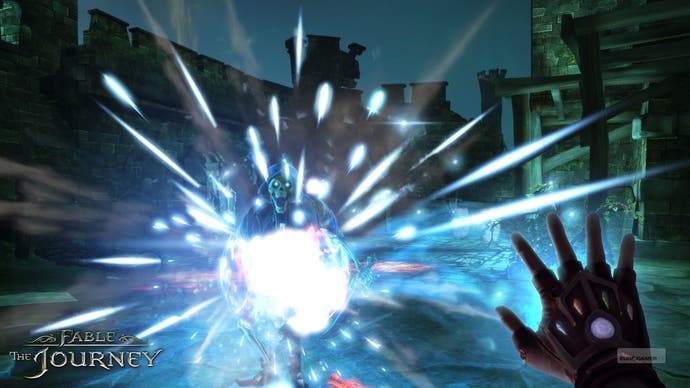
On foot you switch from rider to magician as you are transformed to finger-splaying mage. Spells issue from your hands, and aftertouch-inducing flicks of the wrist send the magic attacks bolting off in new directions. Sting a Hobbe's behind here, singe a Beowulf there: it's during these moments that the game is at its most lightgun-esque. Thrust your left hand out and you can grasp enemies with a magical tendril, smashing them onto the ground with a downward, frictionless slam of the hand and, as you gather experience points through felling enemies, so you may upgrade your growing clutch of spells and grow your character in power and efficiency.
The rhythm of the story forces the odd stop at a stable, where you may brush Seren with a blind man's double-handed grope or, if you're recently escaped from a brutal battle, pull any arrows from her side with a sharp, esoteric yank. Here you can move around the camp's circumference by leaning your body left and right (also useful for sidestepping incoming projectiles during battle) and engage in simplistic, one-note tasks such as picking apples to feed to the horse, or filling a trough with water.
There's little point to these tasks, save the light satisfaction of taking care of a virtual pet and the reward of a handful of experience points. Elsewhere the only other interaction is opening treasure chests - achieved by yanking two hands upwards as if lifting a weight - most of which yield only dull collectible cards, viewable only in a nested menu. There simply aren't enough economies in this Journey to allow the designers to provide you with interesting pick-ups. The absence of shops precludes money. In the absence of money, what else can they offer but encyclopaedic facts?
The immovable plot and pacing enable Lionhead's designers to step more fully into the role of movie directors, and while the motion capture (reportedly a first for a Fable title) is expressive, the banter between Gabriel and blind Seer Theresa (again voiced by BBC stalwart Zoë Wanamaker) lacks bite, even by the standards of children's drama. There's none of the darker, more illicit humour of the previous titles and while this is a game clearly aimed at a younger audience - to view it as anything else is a mistake - Albion is a less interesting place when viewed through wide, innocent eyes.

Fable: The Journey is the first and probably final motion-controlled heroic voyage. Regardless of whether the game was a contractual obligation to Microsoft or just a last-ditch use for Lionhead's virtual boy Milo - the AI buddy squeezed into a horse costume and booted out into Albion's fields to pay for his Guildford lodging - it seems unlikely we'll see such a daring project surface again anytime soon.
It's a game inspired by Molyneux madness, a designer now absent from Fable's lands; a designer without whom this project would likely never have bolted from the stable door. As such it's unique, unlikely and uneven, but also the kind of unsafe game that is rarely created in mainstream circles these days. For that reason, despite the simplicity, the linearity, the dearth of meaningful systems, it is also curiously fascinating.
